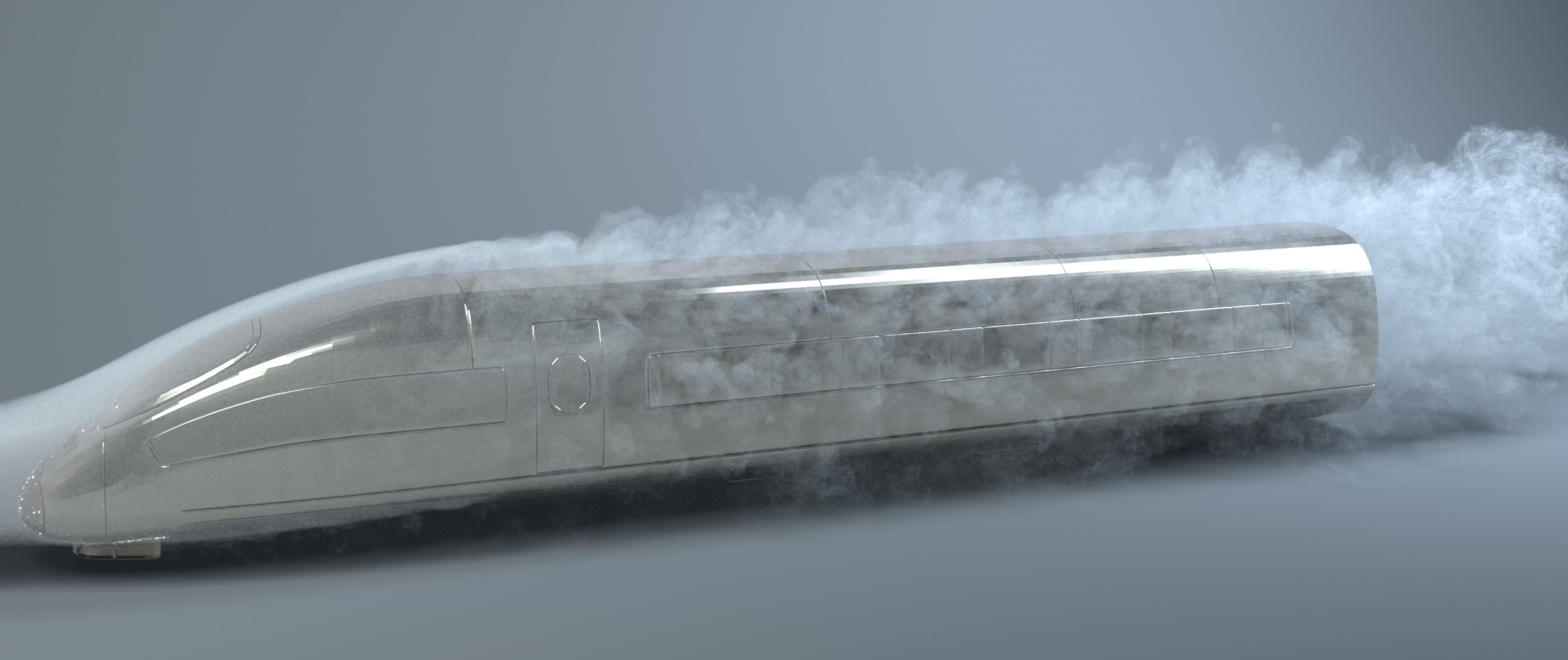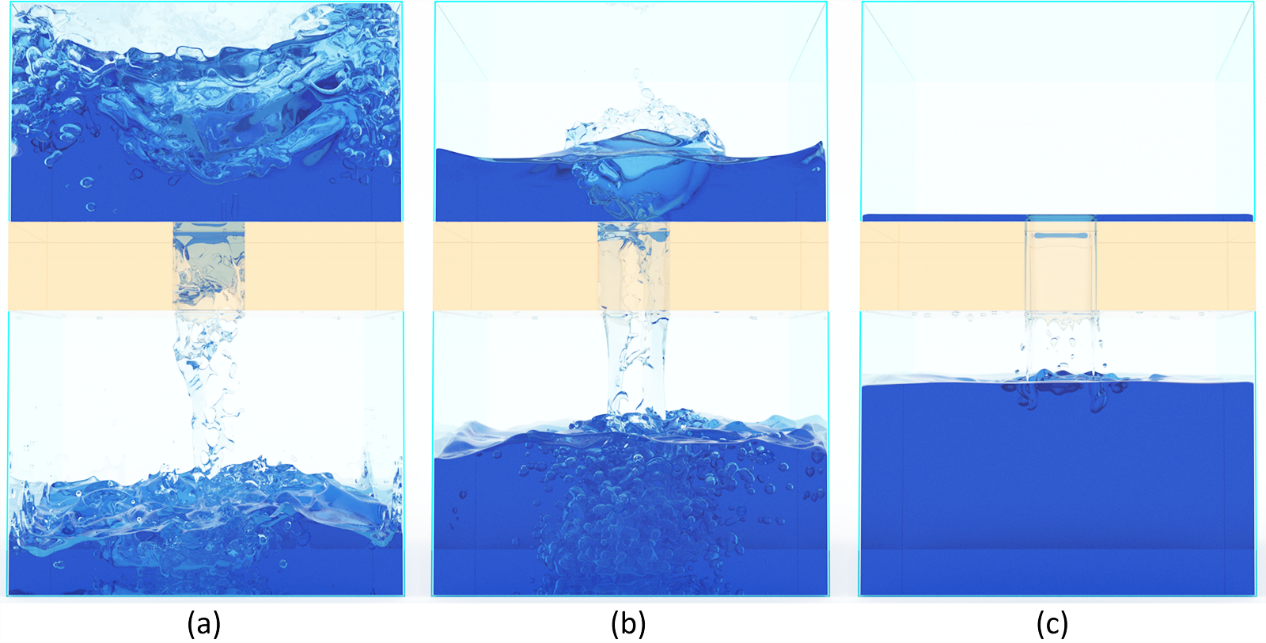In 2020, Prof. Liu Xiaopei's research team from Vision and Data Intelligence Center of our school published five important papers in ACM SIGGRAPH 2020, ACM Transactions on Graphics, IEEE Transactions on Visualization and Computer Graphics, respectively, which are top-tier conference and journals in computer graphics and visualization (all are CCF-A conference and journals). A series of key problems in high-performance fluid simulation and visualization were solved successfully, which lays an important foundation for further scientific research and industrial applications.
Simulating fluid motion and its coupling with rigid body has important scientific and industrial applications. In the field of computer graphics, it generates visually realistic natural phenomena, which can be applied in special effects of movie industry, games, virtual reality and advertisement. In the field of design, it is used to verify industrial product, such as the geometric shape of aircraft, automobile, architecture etc., in order to accelerate product design cycle, optimize product performance and save design cost; In scientific research, it is used to study the behavior of different fluids to explain unknown complex natural phenomena, such as turbulence.
Prof. Liu Xiaopei's research team has been focusing on the fundamental methods and related applications of high-performance fluid simulation for a long time, and is committed to promoting the development of computing theory and the above application fields. Differing from the traditional macroscopic Navier-Stokes fluid equation solver, Prof. Liu Xiaopei's research team advocates mesoscopic method based on the Boltzmann dynamic model originating from statistical mechanics. The model and the associated numerical method have good parallelism and facilitate high-performance large-scale simulations in parallel computing systems (such as multi-GPU platforms). Thus, the efficiency is expected to be far beyond the traditional method. However, existing modeling method of this approach usually has poor numerical stability and accuracy, preventing their wide-spread use in simulating turbulent flows, which have very common existence.
In order to solve this problem, Prof. Liu Xiaopei's research team proposed an adaptive central-moment collision model, which can effectively suppress the numerical errors in the simulation process of turbulence, so that the method can be applied to high-performance turbulent flow simulation. Their first adaptive central-moment collision model was proposed in 2018 (student Li Wei as the first author), and has shown its advantages over traditional methods in simulating turbulent flows. The paper has been published in IEEE Transactions on Visualization and Computer Graphics (IEEE TVCG, CCF-A journal). Due to the empirical parameters of the model, the research group further proposed a systematic optimization method to determine the model parameters in 2020, which further improved the accuracy for turbulent flow simulation; in addition, two-way coupling with dynamic rigid body motion has also been achieved efficiently, in order to simulate two-way fluid-solid coupling phenomenon with large-scale strong turbulence. The paper has been accepted by ACM SIGGRAPH 2020 conference (ACM SIGGRAPH is the topmost computer graphics conference; the accepted papers were automatically included in the topmost graphics journal ACM Transactions on Graphics (ACM TOG). Both the conference and the journal are CCF-A). Li Wei as the PhD student is the first author of the paper. The paper has become the first using Boltzmann dynamics for high-performance turbulent flow simulation and two-way coupling with rigid body solids in ACM SIGGRAPH, with both stability and accuracy. The supplementary video was also selected into the ACM SIGGRAPH 2020 Technical Paper Trailer. It is worth mentioning that the second author of the paper is Chen Yixin, a 2015 undergraduate student of our school. She has been intensively involved in the related research and is now pursuing her PhD degree at the University of Toronto. Fig. 1 shows an example of the method proposed in the paper to simulate complex tornado flows; Fig. 2 shows an example of a digital wind tunnel built with this method to simulate air flows around a high-speed train.

Fig. 1: The airflow from the bottom four inlets converges to produce a tornado with strong turbulence, and rolls up the cars and cows placed in the scene.

Fig. 2: A high-speed train model is placed in a virtual wind tunnel to simulate the turbulent air motion around it; the air motion is visualized by particle rendering.
To support high-performance turbulent flow simulation, Prof. Liu Xiaopei's research team further collaborated with Prof. Fan Rui in our school to study the parallel optimization for their fluid simulation method on GPU computing system. By optimization, the performance of the method has been improved by two orders of magnitude than that of the traditional method on the same GPU platform, especially with high resolution grids. This method was done by Chen Yixin, a 2015 undergraduate student of our school, as the first author. The paper will soon accepted by IEEE TVCG (CCF-A journal). Fig. 3 shows the result of applying the GPU-optimized fluid simulation method for large-scale high-resolution urban smoke simulation.

Fig. 3: High-performance large-scale turbulent smoke simulation with complex architecture.
To further accelerate the fluid simulation, Prof. Liu Xiaopi's research team proposed a fluid upsampling method based on machine learning. By designing a dictionary-based neural network, the method only needs to simulate low resolution fluid motion, while the high resolution fluid motion can be directly and efficiently synthesized by the network. In particular, compared with existing methods, this new approach has a strong capability to synthesize turbulent flows. The high resolution fluid flow synthesized by this method is consistent with the corresponding high resolution fluid simulation within a wide spectrum range, and has a certain generalization ability, which is expected to be applied to rapid design in the future. This paper was done by PhD student Bai Kai as the first author, and was accepted and published online by the topmost computer graphics journal ACM Transactions on Graphics (ACM TOG, CCF-A journal) in 2020. Fig. 4 shows a series of results of fluid flow upsampling from the paper.

Fig. 4: Four types of results of synthesized high-resolution turbulent smoke flows; the lower left corner corresponds to low-resolution smoke as input to the dictionary neural network.
In addition to simulating air motion, Prof. Liu Xiaopei's research team also proposed a multiphase flow simulation method still based on Boltzmann dynamic model for hydrodynamics. Traditional hydrodynamic simulation method is difficult to produce fluid flows with multiphase phenomena within a unified computational framework, such as the water splashing, bubbling, surface tension, as well as wetting on solid surfaces. In order to solve this problem, the research team proposed a novel optimization-based hybrid discretization scheme, which can support the simulation of multiphase turbulent flows at high density ratio, and thus the water flows can be simulated more realistically. This method was done by PhD student Li Wei as the first author and was accepted and published by IEEE TVCG (CCF-A journal) in 2020. Fig. 5 shows the process of simulating a complex water flow with splashing, bubbling and wetting by the proposed method.

Fig. 5: Simulation of turbulent multi-phase flows with high density ratio. The process of complex bubbling is demonstrated as water flows from the upper container into the lower container (a) to (c).
The fluid simulations mentioned above are all for classical fluid flows (i.e. fluid flows which do not contain quantum mechanical phenomena). In addition to the simulation of classical fluids, Prof. Liu Xiaopei's team also collaborated with theoretical physics researchers on the simulation and visualization of quantum fluids (superfluids). The research team published its first paper on quantum vortex simulation and visualization in IEEE TVCG in 2018 (the topmost journal in visualization, done by research assistant Guo Yulong of the team at that time as the first author). Based on the proposed method, the research team further carried out large-scale quantum turbulence simulation and visualization, and proposed a vectorization method for quantum vortex-core line structures, which clearly demonstrated the structure of large-scale quantum turbulence for the first time; the visualization can also be achieved in real-time, providing an important technical solution for later scientific research in this direction. This paper was done by Dr. Liu Daoming, a postdoctoral research fellow of the team, as the first author, and published in IEEE TVCG in 2020 (IEEE TVCG is the topmost journal for visualization). Fig. 6 shows selected results of real-time visualization of quantum turbulence vortex-core line structures.

Fig. 6: Real-time interactive visualization of quantum turbulence vortex-core line structures.
Through the large number of research mentioned above, Prof. Liu Xiaopei's research team has obtained a series of achievements on fluid simulation technologies with practical application value, and is now exploring the applications in the related fields. In addition, during the process of the above research, Prof. Liu Xiaopei's research team has established close collaborations with top-tier universities both domestically and internationally, including Zhejiang University, California Institute of Technology, Columbia University, and Nanyang Technological University, etc., expanding the research exchange, and laid a solid foundation for further research and application in the related areas.
Publication link:
http://faculty.sist.shanghaitech.edu.cn/faculty/liuxp/flare/zh/publications.html




 沪公网安备 31011502006855号
沪公网安备 31011502006855号


